
The Rubik's Cube is a 3-D combination puzzle invented in 1974 by Hungarian sculptor and professor of architecture Ernő Rubik. Originally called the Magic Cube, the puzzle was licensed by Rubik to be sold by Pentangle Puzzles in the UK in 1978, and then by Ideal Toy Corp in 1980 via businessman Tibor Laczi and Seven Towns founder Tom Kremer. The cube was released internationally in 1980 and became one of the most recognized icons in popular culture. It won the 1980 German Game of the Year special award for Best Puzzle. As of March 2021, over 450 million cubes had been sold worldwide, making it the world's bestselling puzzle game and bestselling toy. The Rubik's Cube was inducted into the US National Toy Hall of Fame in 2014.
A puzzle is a game, problem, or toy that tests a person's ingenuity or knowledge. In a puzzle, the solver is expected to put pieces together in a logical way, in order to arrive at the correct or fun solution of the puzzle. There are different genres of puzzles, such as crossword puzzles, word-search puzzles, number puzzles, relational puzzles, and logic puzzles. The academic study of puzzles is called enigmatology.

The Rubik's Revenge is a 4×4×4 version of the Rubik's Cube. It was released in 1981. Invented by Péter Sebestény, the cube was nearly called the Sebestény Cube until a somewhat last-minute decision changed the puzzle's name to attract fans of the original Rubik's Cube. Unlike the original puzzle, it has no fixed faces: the center faces are free to move to different positions.

Ernő Rubik is a Hungarian inventor, architect, and professor of architecture. He is best known for the invention of mechanical puzzles including the Rubik's Cube (1974), Rubik's Magic, Rubik's Magic: Master Edition, and Rubik's Snake.
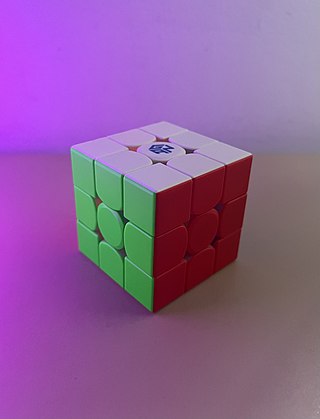
Speedcubing is a competitive sport that involves solving a variety of combination puzzles, the most well-known of which is the 3x3x3 puzzle, as quickly as possible. A person who competitively solves combination puzzles is called a speedcuber, or simply a cuber. To solve most puzzles, one must perform algorithms in a specific order.

The Professor's Cube is a 5×5×5 version of the original Rubik's Cube. It has qualities in common with both the 3×3×3 Rubik's Cube and the 4×4×4 Rubik's Revenge, and solution strategies for both can be applied.
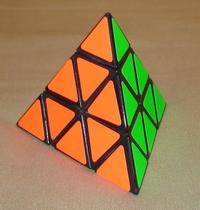
The Pyraminx is a regular tetrahedron puzzle in the style of Rubik's Cube. It was made and patented by Uwe Mèffert after the original 3 layered Rubik's Cube by Ernő Rubik, and introduced by Tomy Toys of Japan in 1981.
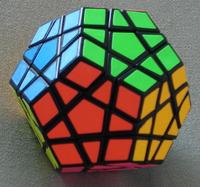
The Megaminx or Mégaminx is a dodecahedron-shaped puzzle similar to the Rubik's Cube. It has a total of 50 movable pieces to rearrange, compared to the 20 movable pieces of the Rubik's Cube.

Uwe Mèffert was a German puzzle designer and inventor. He manufactured and sold mechanical puzzles in the style of Rubik's Cube since the Cube craze of the 1980s. His first design was the Pyraminx – which he had developed before the original Rubik's Cube was invented. He created his own puzzle company and helped bring to market the Megaminx, Skewb, Skewb Diamond and many other puzzles.

Ideal Toy Company was an American toy company founded by Morris Michtom and his wife, Rose. During the post–World War II baby boom era, Ideal became the largest doll-making company in the United States. Their most popular dolls included Betsy Wetsy, Toni, Saucy Walker, Shirley Temple, Miss Revlon, Patti Playpal, Tammy, Thumbelina, Tiny Thumbelina, and Crissy. The company is also known for selling the Rubik's Cube.

The Duncan Toys Company is an American toy manufacturer based in Middlefield, Ohio. The company was founded in 1929 by Donald F. Duncan Sr. and purchased the Flores Yo-Yo Company from Pedro Flores, who brought the yo-yo to the United States from the Philippines. Duncan popularized the yo-yo through competitions that spread throughout the country, publicized in his publications by William Randolph Hearst in exchange for a requirement that contestants had to sell subscriptions to Hearst newspapers as a condition of entry. In 1965, a federal court ruled that Duncan did not have exclusive rights to the word "yo-yo" because the word had become a part of common speech. In 1968, Duncan Toys became a division of Flambeau.
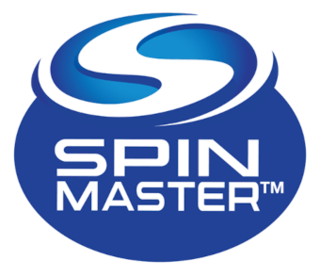
Spin Master Corp. is a Canadian multinational children's toy and entertainment company. Spin Master employs over 1,600 people globally with offices in Australia, Canada, China, France, Germany, Hong Kong, India, Italy, Japan, Mexico, the Netherlands, Poland, Slovakia, Sweden, the United Kingdom, the United States, and Vietnam.

Rubik's 360 is a 3D mechanical puzzle released in 2009 by Ernő Rubik, the inventor of Rubik's Cube and other puzzles. Rubik's 360 was introduced on February 5, 2009 at the Nürnberg International Toy Fair ahead of its worldwide release in August.

The Void Cube is a 3-D mechanical puzzle similar to a Rubik's Cube, with the notable difference being that the center pieces are missing, which causes the puzzle to resemble a level 1 Menger sponge. The core used on the Rubik's Cube is also absent, creating holes straight through the cube on all three axes. Due to the restricted volume of the puzzle it employs an entirely different structural mechanism from a regular Rubik's Cube, though the possible moves are the same. The Void Cube was invented by Katsuhiko Okamoto. Gentosha Education, in Japan, holds the license to manufacture official Void Cubes. These official designs are also sold under the Rubik's brand, owned by Spin Master Ltd., and workalikes are available from a variety of manufacturers. Speed-solving the Void Cube is common in exhibition but is not an official World Cube Association competition event.

RuBot II is a Rubik's Cube solving robot developed by Irish roboticist and inventor Pete Redmond. RuBot II is also known as RuBot II, the Cubinator. RuBot II became the world's fastest Rubik's Cube-solving robot, and appeared as such in the Guinness Book of World Records. There are other Rubik's Cube robots too.
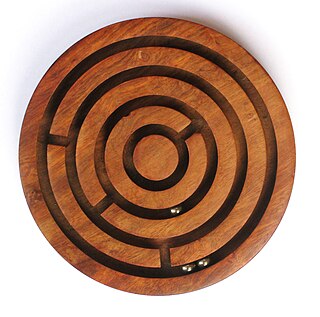
Ball-in-a-maze puzzles are dexterity puzzles which involve manipulating either a maze or one or several balls so that the ball or balls are maneuvered towards a goal. Toys like this have been popular since Pigs in Clover was invented by Charles Martin Crandall and then patented on September 10, 1889. The game was a craze in the United States from mid-February to May 1889, at 8 000 puzzles being produced daily according to The Waverly Free Press. It was played at home, on buses, in the street, parks, and even by US politicians. Sam Loyd falsely claimed to have invented it in an interview in 1891.
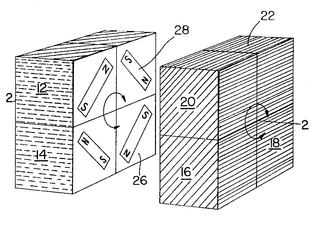
Larry D. Nichols, born 1939 in the United States, is a puzzle designer. He grew up in Xenia, Ohio, and studied chemistry at DePauw University in Greencastle, Indiana, before moving to Massachusetts to attend Harvard Graduate School. He is best known for the invention of mechanical puzzles including 'The Nichols Cube Puzzle' (1974), patent US365520. He has lived with his wife Karen in Arlington, Massachusetts since 1959.

The Gear Cube is a 3-D combination puzzle designed and created by Dutch puzzle maker Oskar van Deventer based on an idea by Bram Cohen. It was initially produced by Shapeways in 2009 and known as "Caution Cube" due to the likelihood of getting one's fingers stuck between the gears while speedcubing. Later, in 2010, it was mass-produced by Meffert's as the "Gear Cube".



















